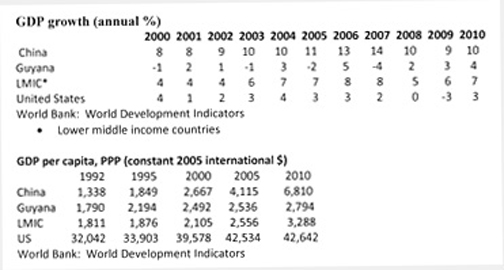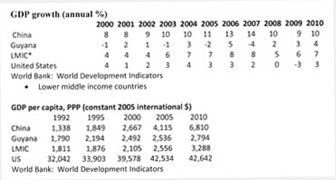In 1984 I had $24,000 in the bank and now I have $10 million and my less discerning friends tell me I am doing well. The problem with their assessment is that in 1984 I paid $24,000 for the house lot on which I now live but if today I wanted to purchase a similar piece of land in the same area I would have to find $15 million. At least in terms of the price of land where I live, I am significantly worse off today than I was in 1984: at today’s value I had the equivalent of $15 million in the bank in 1984. Perhaps if the PPP/C presidential candidate had taken these kinds of considerations into account, during the recent University of Guyana debate, he would not have annoyed the students with the bald comparison between the $18,000 per month lecturers received in 1992 and the $165,000 they receive today.

The above said, last week I argued that repetition is one of Goebbels’ major principles of propaganda and that it incorporates the use of both repetitive speech and repetitive activity. Thus, for example, the more publicly active ministers of government (those “always in the public eye” so to speak) are usually the most popular and viewed as being most efficient largely because the public is susceptible to “input politics” with very little consideration given to what actually results from the well-publicised activities. So, propaganda aside, let us consider what has been the actual output of the general busy-ness we have been witnessing in one fundamental area of government policy.
The PPP/C’s manifesto claims that there has been: “Sustained economic growth and expansion, with the economy as a whole growing from a size of US$274 million in 1991 to US$2,261 million in 2010, per capita income rising from US$304 in 1991 to US$2,533 in 2010, and uninterrupted positive growth in real gross domestic product since the floods of 2005 of about 5 percent despite prevailing global recession.”
What the PPP/C has presented as growth in their manifesto is not dissimilar to saying I am well off because I now have $10 million instead of $24,000 in the bank. They have taken the 1991 GSP and compared it with that of 2010 without using a deflator. I have pointed to this bogus use of national statistics before, but over the last few weeks Professor Clive Thomas has again been writing articles in the Sunday Stabroek titled “The official misuse and abuse of Guyana’s economic statistics” in which he claimed that: “the GDP at current prices has to be deflated by a GDP deflator … to arrive at real GDP growth before making comparisons over time for the same country.”
Therefore, if the government’s statistics are not credible, where should we look? The PPP/C government claims to have rebased the economy on 2006 prices but is unable to go back to earlier years, using the 2006 prices, to allow for proper comparisons. However, the World Bank provides some statistics based on 2005 international dollars (an international dollar has the same purchasing power over GDP as the U.S. dollar has in the United States) prices, which allow us to make a better assessment.
The data for China and America are provided because many of us are more familiar with the trend in these countries and thus will be able to note that the statistics are not biased against Guyana. They point to growth in China and stagnation and decline in America in the years we expect them to. Guyana is usually said to be in the Lower Middle Income group and therefore it is best to judge its development against that category.
What the numbers show is that Guyana has not done well, particularly over the last decade or so; its rate of growth has not been nearly as good as the LMIC category. Indeed, in relation to these countries, Guyana is falling back. For example, in 2000 Guyana had a higher GDP per capita income than the LMI countries but today it is lower. We know that China has had phenomenal growth and although one does not necessarily expect this from Guyana, the figures, using 2005 international prices, indicate that Guyana has grown only slightly over the decade. The per capita GDP which was $2,492 in 2000 was only $2,794 in $2010: a growth averaging about 1.2 percent per annum while the lower middle income countries have grown by some 6 percent per annum.
Production of Major Commodities
*Bank of Guyana Report for the stated years
But let us look at actual production output over the period. The production of our major commodities has seen stagnation and/or decline. Sugar production was much less in 2010 than in 2002 and rice production was not much more in 2010 than it was in 2003. Forestry production was less in 2010 than it was in 2004 and bauxite production appears in irreversible decline.
Without adequate growth self-sustained development is impossible. Governments may appear very busy and be able to borrow or to severely increase taxes to give the impression of growth and development at election times but such outcomes are ephemeral and may eventually lead to economic disaster. The data above allow for many other comparisons, but none of them could justify the propagandistic claim that a “wave of progress is spreading through Guyana” that will take us to even greater heights or that Guyana is now the “star of the Caribbean.” Nothing is further from the truth: it is all propaganda. Politics is about voters using their franchise to ‘purchase’ the politician they want: “let the buyer beware!”
henryjeffrey@yahoo.com








